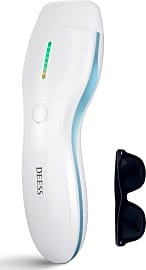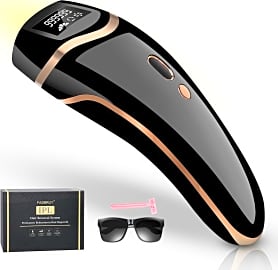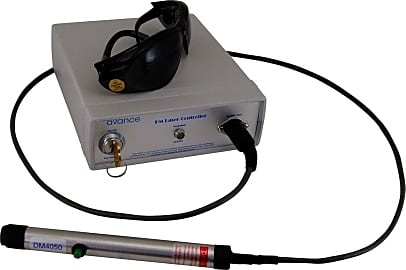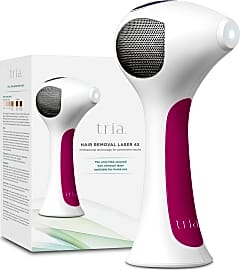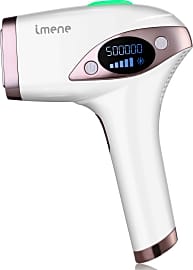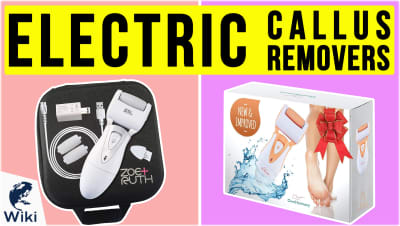The 10 Best Hair Removal Lasers

This wiki has been updated 43 times since it was first published in March of 2015. Yes, ladies, we know that shaving those legs and other areas is a royal pain, but these days, even fellas who spend a great deal of time on manscaping can benefit from using one of these hair removal lasers. They promise to give you silky-smooth skin on most parts of your body in the comfort of your own home — no expensive visit to the salon necessary. Say goodbye to razor burn forever. When users buy our independently chosen editorial choices, we may earn commissions to help fund the Wiki.
Editor's Notes
December 13, 2020:
Most of the machines on this list use IPL technology, which stands for Intense Pulsed Light, the same method that’s used in most beauty spas that offer laser hair removal. These aren’t effective on all skin tones, because they generally work by finding dark hairs that contrast with lighter skin, so if you’re trying to remove blond or gray hairs, or your skin tone is fairly dark, other hair removal methods will work better for you.
If you do fall in the category of people for whom this method could be effective, be prepared for a lengthy commitment; the IPL system requires many months of use to reduce hair growth, and full treatments often take 8-12 months. We’ve got some new additions to the list, although we liked the Deess Series 3, Biotechnique Avance DM-4050-DLX, and Braun Gillette Venus Silk enough to keep them on the list, but keep in mind that the Biotechnique has a small wand meant for use on the face more than on the body.
The new models that we found to be effective include the Fasbruy IPL, the powerful Remington iLight Pro, which delivers results more quickly than with many other machines, and the Silk’n Infinity, which users report works even on medium-dark skin tones. While eye protection is recommended for most of these (they do use lasers, after all), those with eye sensitivity may particularly like the Tria Beauty 4X, since its light emission isn’t too intense.
If you’d like a real at-home spa experience, the BoSidin Permanent comes with glasses and razors, and even has a mode to freshen and rejuvenate skin tone on areas where you don’t need hair removal. Keep in mind that while the IPL method isn’t as uncomfortable as, for instance, epilation (which yanks hairs right out), it’s rarely completely painless. You may want to be prepared with an aloe vera cream in case you have any redness or inflammation after home laser sessions.
May 08, 2019:
You never know where unsightly hair might try to claim territory on your body, so we included laser hair removal tools that can tackle just about any region. The Philips Lumea Prestige has attachments specifically designed for those tricker areas, like under the arms and around the bikini region, The Biotechnique Avance DM-4050-DLX is a kit ready for precision work on the face, such as shaping eyebrows and attacking upper lip hairs. With its thin build, it can do highly detailed work and you'll look like you spent hundreds on a salon treatment. The Elos Touch Advance, though ready for larger areas, has a precision adapter for more delicate regions, too. Any time you skip the professional to do something yourself, there's always worry of making mistakes, so we made sure our choices are user-friendly. The Qmele IPL Device shows the intensity level, flashes left, and current function on its screen. Plus, its lamp head is a breeze to replace. Both the Deess Series 3 and the Deess 025 are simple to adjust and maneuver with just one hand. Meanwhile, the Elos Touch Advance comes with an instructional DVD, so there should be no confusion about how to use it.
The Benefits Of Hair Removal Lasers
Hair removal lasers are most effective on hairs in the anagen stage of growth, which is when the hair is actively growing.
The hair on the outer body grows in four stages. In the anagen stage, the hair grows out to its full length. The catagen phase is characterized by a shrinking hair follicle that detaches from the dermal papilla. In the telogen phase, the hair rests for about three months, while replacement hair begins to grow behind it. The last phase is the exogen phase, in which the hair sheds from the follicle to be replaced by a new one.
Hair removal lasers are most effective on hairs in the anagen stage of growth, which is when the hair is actively growing. This is why dermatologists will recommend using a regular laser hair removal schedule; as each hair is in a different phase of its growth. To noticeably reduce the number of hairs on the body, the process has to be repeated regularly for a period of time.
Using a hair removal laser in the home saves an enormous amount of time and money. Rather than spending countless hours scheduling, driving to, and waiting for dermatologist appointments, hair can simply be removed from the body from the comfort of the home. Additionally, the one-time cost of a personal hair removal laser is drastically less than a regular series of appointments with a dermatologist.
The precision of these products is undeniable. Many lasers have been designed to only target the hair follicle itself, and leave the epidermis unaffected.
The results of using a hair removal laser are long-lasting and highly effective. If done regularly, laser removal can noticeably reduce the number of hairs on the body. The hairs that remain are also less noticeable; as they are generally softer and lighter in color.
Ancient Hair Removal
The act of removing hair reaches far into the annals of time. In as early as 4,000 BCE, women and men were using various methods to remove hair from their bodies. The ancient Egyptian culture had relatively advanced medicinal practices for their time.
Greek and Egyptian women were hairless, with the exception of the eyebrows and head.
Men of high class in Egypt used sharp flint stones or even bronze razors to remove facial hair, and both sexes used early forms of waxing to remove the rest of the hair on the body. While the ancient Egyptian culture did appreciate the sleek look of having no hair, this also served a health purpose. A body free of hair provided less of a breeding ground for lice and mites.
Hair removal was also indicative of class in ancient Greek and Roman cultures. Wealthy women would remove body hair with simple razors, pumice stones, tweezers, and even early hair removal creams. In Greek men, the act of shaving the face became commonplace with Alexander the Great, who shaved his beard before a battle, believing it would save him from decapitation. He ordered his men to do the same, and from that day on, a clean-shaven face became synonymous with progress and vigor. This was a large cultural shift.
Before that event beards were seen as a symbol of power and manhood. Roman culture soon followed suit as poets, writers, and painters began accepting the idea. This cemented the notion that a hairless face was the ultimate symbol of civilization.
The notion that body hair was considered unworthy was not limited to men. Women in ancient cultures also viewed body hair as unclean. Greek and Egyptian women were hairless, with the exception of the eyebrows and head. In ancient Middle Eastern countries such as Turkey, Lebanon, and Palestine, brides were also expected to remove all hair below their eyebrows on the eve of their wedding. Some African tribes even plucked or shaved their hair.
Knowing Where To Remove Hair
While hair removal has become a common practice across most of the world, it is important to know that not all hair is created equal. Hairs from some areas of the body can be removed with little repercussion, while the hair in other areas actually serve an important function in the body
A team of researchers in Australia studied over 150 species of primates to discover how they use personal ornamentation to increase their chances of finding a mate.
Though the corporate world condemns large beards, there are many uses for them. Beards act to protect the face from UV rays, reducing the risk of aging and skin damage. The presence of a beard may actually make a man [more attractive to women]. A team of researchers in Australia studied over 150 species of primates to discover how they use personal ornamentation to increase their chances of finding a mate.
Researchers found that primates who lived in larger, more social environments had to use flamboyant and highly conspicuous ornaments to stand out. It works much the same for humans, with examples of phenotypical ornamentation being facial hair, piercings, and tattoos.
Pubic hair may actually play an important role in the body as well. Though research is finding that most women prefer to groom their pubic hair, it may not be entirely healthy. The pubic hair has evolved with the body for thousands of years, and serves its own necessary role in health. Pubic hair protects the genitals from foreign particles and acts to spread pheromones created by sebaceous glands; which can subconsciously attract the opposite sex. The presence of pubic hair also acts to reduce unnecessary friction and avoid cases of vulvodynia in women.




